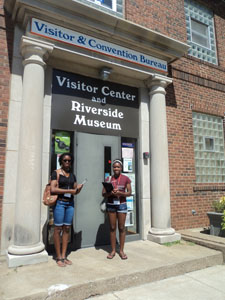|
Seek and You Shall Find: Free Press Reporters Discover a Treat in La Crosse
by Adaeze Okoli, age 18

One of our favorite museums opens again on Memorial Day. Last fall, fellow teen editor Taylor Kilgore and I had the opportunity to visit La Crosse.
On a clear afternoon we milled around the town and walked up and down the quaint streets of downtown La Crosse. We went a lot of places and visited a number of interesting sites during our weekend in La Crosse, including a fascinating conference on space science hosted by UW-La Crosse. But, we are reporters and we love to explore. So, maps in hand, off we went in search of a good story.
At the end of a path going along the Mississippi River, we found the Riverside Museum. Operated by the La Crosse County Historical Society, the Riverside Museum is one of three museums recounting the extensive history of the La Crosse area. The Riverside Museum focuses on how La Crosse has been affected by the Mississippi River and the surrounding landscape.
The exhibit began by explaining the geography of this part of the Midwest. The La Crosse region, Southwest Wisconsin, and parts of Minnesota and Iowa were bypassed by the glaciers during the Ice Age, leaving the area with a much different appearance than a characteristic flat Midwestern landscape. Today we call this region the Driftless Area. The rolling hills, thick deciduous forests, and powerful rivers paved the way for a booming lumber industry during the 19th century.
During the 1800’s, sawmills helped open the La Crosse region to business and economic prosperity. Between 1870 and 1880, there were approximately 33 sawmills in the La Crosse area. The confluence of the Black, La Crosse, and Mississippi Rivers made La Crosse a prime location for transporting lumber from the forests in the northern and western parts of Wisconsin.
The booming lumber business attracted many new people to the La Crosse area. They were looking for work. Families from other countries immigrated to the United States during this period. Many settled in La Crosse because of the success of the lumber industry.
With hundreds of people moving to the area and great opportunity for business, La Crosse quickly became one of America’s busiest steamboat centers.
In tribute to that era in La Crosse history, the museum has acquired a relic of the period, The War Eagle. The War Eagle was a long-running steamboat that carried people, materials, and livestock down the Mississippi River. The War Eagle now makes its home outside the Riverside Museum, and visitors can see and tour the steamboat.
La Crosse has a rich history of business and prosperity. The Riverside Museum is just one of many fun and interesting things to see in La Crosse. We were fascinated by the way this museum manages to showcase the region’s maritime history and La Crosse’s vibrant past. We highly recommend stopping by this museum if you ever have the chance to visit La Crosse. The museum is open Memorial Day to Labor Day. For more information about the Riverside Museum visit www.lchsweb.org.
We also recommend taking the highway 14 route to get to La Crosse. If you do, you will have plenty of opportunity to see the unusual landscapes of Wisconsin’s Driftless Area. It really is beautiful and there are plenty of interesting sites to visit along the way.
|

